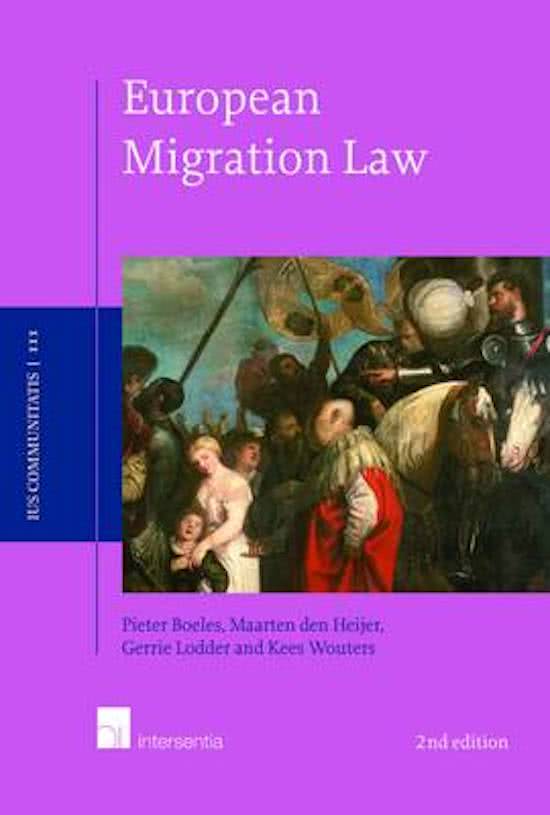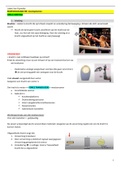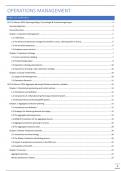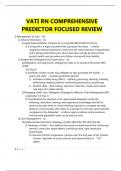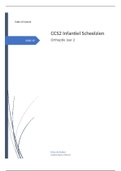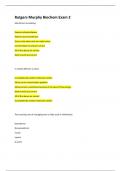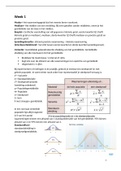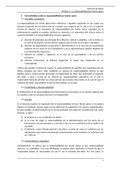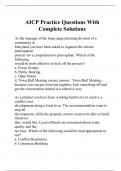EU migration law: forced and unforced migration to the EU
Lecture 1: introduction and borders
>>>> About the family Noor:
The family Noor is from Afghanistan and Fareed Noor is the head of the family. He has an extended
family with his wife, father, brother (uncle of the children), three children (two minor children and a
son older than 18). Fareed prefers to build a life with his family in the EU.
- Who belongs to the nuclear family?
A nuclear family, elementary family or conjugal family is a family group consisting of parents
and their children (one or more). The ECtHR defines the nuclear family as the head of the
family, the spouse and minor children. In this family, the nuclear family consists of Fareed, his
wife and his two minor children.
>>>> Introduction to EU migration law:
Legal-historical development:
Schengen Treaty (1985, 1990) – gradual abolition of internal borders:
Art. 17 Schengen Treaty can be seen as the key historical motivation/rationale behind the existence of
EU migration law. The Schengen Treaty is associated with no more internal border controls.
- Art. 17 Schengen Treaty provides: “With regard to the movement of persons, the parties shall
endeavor to abolish checks at common borders and transfer them to their external borders.
To that end they shall endeavor first to harmonize, where necessary, the laws, regulations and
administrative provisions concerning the prohibitions and restrictions on which the checks are
based and to take complementary measures to safeguard internal security and prevent illegal
immigration by nationals of states that are not members of the European Communities”.
o Why are there border checks?
There are many reasons why there are border checks: to prevent illegal goods from coming
in, to prevent fugitives from escaping our own nationals, to prevent illegal persons from
coming in, to ensure that persons entering the country have a valid reason.
• The abolition of internal border controls has effect on all these areas. Hence, states
realized that they would have to harmonize laws, regulations and administrative
provisions. So, the Schengen Treaty gave rise to a huge legislative impetus.
à EXAMPLE: Schengen Implementing System (SIS) is a database with information
about wanted persons.
The Schengen Acquis consists of the two Schengen Treaties and the decisions of the implementing
committee about no internal border controls, common external borders, and a few close related
matters, such as the visa policy and SIS (the database that border guards are checking).
Treaty of Amsterdam (1997) and Treaty of Lisbon (2007):
Afterwards, most of the Schengen Acquis has been incorporated into EU law.
- The Treaty of Amsterdam made the EU competent on all those issues (border controls, asylum,
migration, criminal law).
- The Treaty of Lisbon increased the competences in multiple ways to adopt legislation in all
those spheres.
1
,Enlargement:
Over the years, the EU has enlarged and with that the parties to the Schengen Treaty also enlarged.
- The law on border control, asylum and migration was originally formed only by five states, but
now it is formed by thirty states.
- Some EU states are not parties to the Schengen Treaty (such as Ireland and Denmark) and
these are therefore opt-out countries; on the other hand, some non-EU states are parties to
the Schengen Treaty (such as Switzerland, Liechtenstein, Norway and Iceland) and these are
therefore opt-in countries; and finally, there are EU states that are not yet parties to the
Schengen Treaty (such as Bulgaria, Romania and Cyprus), because they do not (yet) meet the
requirements to join the Schengen area.
Multi-level structure:
The legal position of individual migrants is formed by multiple areas and sources of law, which
sometimes conflict with one another. The following sources are relevant for migration law:
- Worldwide international law: Refugee Convention, ICCPR, Convention against Torture (CAT),
including the prohibition of non-refoulement.
à NOTE: this also includes the UN and treaty monitoring bodies.
- Regional international law: ECHR, including the prohibition of non-refoulement.
à NOTE: this also includes the Council of Europe and the ECtHR (which laid down the
fundaments of how migrants should be treated).
- EU law:
o TFEU and EU Charter of Fundamental Rights.
• These instruments do not grant third-country nationals strong rights, but they give the
EU the competence to legislate their legal position.
o Regulations and directives:
• Regulations have direct effect in EU member states and may not even be transposed
in national law.
• Directives must be transposed to have effect.
o Association Treaties/EEA.
à NOTE: this also includes the CJEU and national courts.
- National law of the EU member states:
o There are differences in how national law relates to international law through monist and
dualist systems.
à NOTE: this also includes national courts.
Legal categories:
For a long time, the most important distinction that was made in EU migration law is the distinction
between EU citizens versus third-country nationals (tcn). However, now the most important distinction
is the distinction between citizens versus non-citizens (=> nationals versus aliens).
- Within the category of third-country nationals there is a further distinction between migrants
versus refugees and between regular migration and asylum.
2
,Third-country national:
Third-country national means any person who is:
- Not a citizen of the EU.
- Not a third-country national who is a family member of an EU citizen exercising his or her right
to free movement.
o This implies that if you are a third-country national, but you are a family member of an EU
citizen who is moving from one member state to another member state, you are treated
as an EU citizen.
• What is the reason behind this?
To protect the right of the EU citizen (especially the right to family life).
- Not a person who, under an agreement between the EU and a third country, enjoys rights of
free movement equivalent to those of EU citizens.
>>>> The EU external border – how to get there and how to cross it:
About the family Noor:
The Taliban took over in Afghanistan and Fareed Noor, who is an enlightened Muslim, does not like
the situation in Afghanistan. Like many other Afghans he wants to establish his life elsewhere and he
does think he has a chance to be granted asylum. If granted asylum, there may be a right for at least
some of his family members to join him.
- Fareed wants to go to Amsterdam. What is your (legal) advice?
There are a couple of options:
a. He should buy an airline ticket to Amsterdam
à NOTE: this is not a realistic option for Fareed, because the airline would not allow him
to board the airplane without a valid visa as the airline gets sanctioned by the EU member
states if it lets people on the airplane without a visa (art. 26 Schengen Implementing
Agreement).
b. He should hire the services of a smuggler (Qatar – Libya – Italy – NL)
à NOTE: chances are Fareed is either pushed back or pulled back by the Libyan coastguard
and every time Fareed has to pay. Hence, this is not a good option.
c. He will never make it to Amsterdam and should stay home with his family
d. He should opt for Rome instead of Amsterdam (via Libya)
à NOTE: it is more likely that Fareed’s application for asylum will be processed by Italy, as
that is the country of first entrance (Dublin Regulation).
Legal rules:
Schengen Borders code:
There is an obligation on EU member states to thoroughly check third-country nationals who present
themselves at the EU external border, according to the Schengen Borders Code.
External borders:
- There are common rules on external border controls (art. 5 – 14).
- Art. 6 lists the entry conditions the third-country national has to meet in order to cross the
external border: valid travel document (passport); sufficient funds for stay and return; in
possession of a valid visa; no SIS alert (fugitive convicts, suspects, aliens with entry bans); no
threat to the public policy, internal security or public health.
3
, à NB: there is an exception for persons who have a residence permit or a long-stay visa.
o The EU visa list (Regulation 2018/1806) sets forth the nationals of the states that are
subject to the visa obligation. The conditions to be granted a visa are listed in art. 14 of the
EU visa code.
• This system of the visa obligations is effectively enforced when it comes to air travel
because of carrier sanctions. According to art. 26 Schengen Implementing Agreement,
if aliens are refused entry into the territory of one of the contracting parties, the carrier
which brought them shall be obliged to return the aliens to the third state from which
they were transported. In addition, it provides that the contracting parties undertake
to impose penalties on carriers which transport aliens who do not possess the
necessary travel documents by air or sea from a third state to their territory. Because
carriers don’t want this, they check upon boarding whether the passenger has a visa.
- Art. 14 provides that a third-country national who does not fulfil all the entry conditions laid
down in art. 6(1) shall be refused entry to the territories of the member states. This shall be
without prejudice to the application of special provisions concerning the right of asylum or the
issue of long-stay visas.
o If a person doesn’t meet the entry conditions, he can apply for asylum because in that case
another set of rules apply. In that case, he will not simply be refused entry and he must be
granted entry into an asylum procedure.
Internal borders:
- There are no internal border controls (art. 22), but there are some exceptions (arts. 25 – 35).
o Starting point: there are no internal border controls (art. 22).
o Exceptions: there are still countries who, even though there is a prohibition to have
internal border controls, have internal border controls and they use the recognized
exceptions in the Schengen Borders Code.
• The regime for allowing these exceptions is strict: the reintroduction of the internal
border controls must be temporary, and the EU member state must inform the other
EU member states and the European Commission (art. 27)
Case law:
ECtHR N.D. and N.T. v Spain:
This case concerns migrants trying to enter the EU via one of the most used routes, namely the Spanish
exclaves in Melilla. There are three rows of fences to keep the migrants out. The Spanish legislation
stated that only if a migrant successfully crosses all three fences and arrives on Spanish soil, he will not
be expelled immediately and he will be allowed entry in a procedure, whereas if the migrant does not
manage to arrive on the Spanish soil he will be handed over to the Moroccan police. The argument
brought was that pulling migrants from fences and returning them to Morocco without procedure was
in violation of the prohibition against collective expulsion (art. 4 Protocol 4 ECHR). According to this
prohibition, persons may not be expelled in a group, and this entails that all migrants must have a
genuine and effective possibility of submitting individual arguments against their expulsion and the
country must take those arguments seriously before that migrant can be expelled.
- What is Spain’s view on this matter?
Instead of storming the fences in Melilla, the migrants should use the established border
checkpoints and other procedures in place to enter Spain.
4
Lecture 1: introduction and borders
>>>> About the family Noor:
The family Noor is from Afghanistan and Fareed Noor is the head of the family. He has an extended
family with his wife, father, brother (uncle of the children), three children (two minor children and a
son older than 18). Fareed prefers to build a life with his family in the EU.
- Who belongs to the nuclear family?
A nuclear family, elementary family or conjugal family is a family group consisting of parents
and their children (one or more). The ECtHR defines the nuclear family as the head of the
family, the spouse and minor children. In this family, the nuclear family consists of Fareed, his
wife and his two minor children.
>>>> Introduction to EU migration law:
Legal-historical development:
Schengen Treaty (1985, 1990) – gradual abolition of internal borders:
Art. 17 Schengen Treaty can be seen as the key historical motivation/rationale behind the existence of
EU migration law. The Schengen Treaty is associated with no more internal border controls.
- Art. 17 Schengen Treaty provides: “With regard to the movement of persons, the parties shall
endeavor to abolish checks at common borders and transfer them to their external borders.
To that end they shall endeavor first to harmonize, where necessary, the laws, regulations and
administrative provisions concerning the prohibitions and restrictions on which the checks are
based and to take complementary measures to safeguard internal security and prevent illegal
immigration by nationals of states that are not members of the European Communities”.
o Why are there border checks?
There are many reasons why there are border checks: to prevent illegal goods from coming
in, to prevent fugitives from escaping our own nationals, to prevent illegal persons from
coming in, to ensure that persons entering the country have a valid reason.
• The abolition of internal border controls has effect on all these areas. Hence, states
realized that they would have to harmonize laws, regulations and administrative
provisions. So, the Schengen Treaty gave rise to a huge legislative impetus.
à EXAMPLE: Schengen Implementing System (SIS) is a database with information
about wanted persons.
The Schengen Acquis consists of the two Schengen Treaties and the decisions of the implementing
committee about no internal border controls, common external borders, and a few close related
matters, such as the visa policy and SIS (the database that border guards are checking).
Treaty of Amsterdam (1997) and Treaty of Lisbon (2007):
Afterwards, most of the Schengen Acquis has been incorporated into EU law.
- The Treaty of Amsterdam made the EU competent on all those issues (border controls, asylum,
migration, criminal law).
- The Treaty of Lisbon increased the competences in multiple ways to adopt legislation in all
those spheres.
1
,Enlargement:
Over the years, the EU has enlarged and with that the parties to the Schengen Treaty also enlarged.
- The law on border control, asylum and migration was originally formed only by five states, but
now it is formed by thirty states.
- Some EU states are not parties to the Schengen Treaty (such as Ireland and Denmark) and
these are therefore opt-out countries; on the other hand, some non-EU states are parties to
the Schengen Treaty (such as Switzerland, Liechtenstein, Norway and Iceland) and these are
therefore opt-in countries; and finally, there are EU states that are not yet parties to the
Schengen Treaty (such as Bulgaria, Romania and Cyprus), because they do not (yet) meet the
requirements to join the Schengen area.
Multi-level structure:
The legal position of individual migrants is formed by multiple areas and sources of law, which
sometimes conflict with one another. The following sources are relevant for migration law:
- Worldwide international law: Refugee Convention, ICCPR, Convention against Torture (CAT),
including the prohibition of non-refoulement.
à NOTE: this also includes the UN and treaty monitoring bodies.
- Regional international law: ECHR, including the prohibition of non-refoulement.
à NOTE: this also includes the Council of Europe and the ECtHR (which laid down the
fundaments of how migrants should be treated).
- EU law:
o TFEU and EU Charter of Fundamental Rights.
• These instruments do not grant third-country nationals strong rights, but they give the
EU the competence to legislate their legal position.
o Regulations and directives:
• Regulations have direct effect in EU member states and may not even be transposed
in national law.
• Directives must be transposed to have effect.
o Association Treaties/EEA.
à NOTE: this also includes the CJEU and national courts.
- National law of the EU member states:
o There are differences in how national law relates to international law through monist and
dualist systems.
à NOTE: this also includes national courts.
Legal categories:
For a long time, the most important distinction that was made in EU migration law is the distinction
between EU citizens versus third-country nationals (tcn). However, now the most important distinction
is the distinction between citizens versus non-citizens (=> nationals versus aliens).
- Within the category of third-country nationals there is a further distinction between migrants
versus refugees and between regular migration and asylum.
2
,Third-country national:
Third-country national means any person who is:
- Not a citizen of the EU.
- Not a third-country national who is a family member of an EU citizen exercising his or her right
to free movement.
o This implies that if you are a third-country national, but you are a family member of an EU
citizen who is moving from one member state to another member state, you are treated
as an EU citizen.
• What is the reason behind this?
To protect the right of the EU citizen (especially the right to family life).
- Not a person who, under an agreement between the EU and a third country, enjoys rights of
free movement equivalent to those of EU citizens.
>>>> The EU external border – how to get there and how to cross it:
About the family Noor:
The Taliban took over in Afghanistan and Fareed Noor, who is an enlightened Muslim, does not like
the situation in Afghanistan. Like many other Afghans he wants to establish his life elsewhere and he
does think he has a chance to be granted asylum. If granted asylum, there may be a right for at least
some of his family members to join him.
- Fareed wants to go to Amsterdam. What is your (legal) advice?
There are a couple of options:
a. He should buy an airline ticket to Amsterdam
à NOTE: this is not a realistic option for Fareed, because the airline would not allow him
to board the airplane without a valid visa as the airline gets sanctioned by the EU member
states if it lets people on the airplane without a visa (art. 26 Schengen Implementing
Agreement).
b. He should hire the services of a smuggler (Qatar – Libya – Italy – NL)
à NOTE: chances are Fareed is either pushed back or pulled back by the Libyan coastguard
and every time Fareed has to pay. Hence, this is not a good option.
c. He will never make it to Amsterdam and should stay home with his family
d. He should opt for Rome instead of Amsterdam (via Libya)
à NOTE: it is more likely that Fareed’s application for asylum will be processed by Italy, as
that is the country of first entrance (Dublin Regulation).
Legal rules:
Schengen Borders code:
There is an obligation on EU member states to thoroughly check third-country nationals who present
themselves at the EU external border, according to the Schengen Borders Code.
External borders:
- There are common rules on external border controls (art. 5 – 14).
- Art. 6 lists the entry conditions the third-country national has to meet in order to cross the
external border: valid travel document (passport); sufficient funds for stay and return; in
possession of a valid visa; no SIS alert (fugitive convicts, suspects, aliens with entry bans); no
threat to the public policy, internal security or public health.
3
, à NB: there is an exception for persons who have a residence permit or a long-stay visa.
o The EU visa list (Regulation 2018/1806) sets forth the nationals of the states that are
subject to the visa obligation. The conditions to be granted a visa are listed in art. 14 of the
EU visa code.
• This system of the visa obligations is effectively enforced when it comes to air travel
because of carrier sanctions. According to art. 26 Schengen Implementing Agreement,
if aliens are refused entry into the territory of one of the contracting parties, the carrier
which brought them shall be obliged to return the aliens to the third state from which
they were transported. In addition, it provides that the contracting parties undertake
to impose penalties on carriers which transport aliens who do not possess the
necessary travel documents by air or sea from a third state to their territory. Because
carriers don’t want this, they check upon boarding whether the passenger has a visa.
- Art. 14 provides that a third-country national who does not fulfil all the entry conditions laid
down in art. 6(1) shall be refused entry to the territories of the member states. This shall be
without prejudice to the application of special provisions concerning the right of asylum or the
issue of long-stay visas.
o If a person doesn’t meet the entry conditions, he can apply for asylum because in that case
another set of rules apply. In that case, he will not simply be refused entry and he must be
granted entry into an asylum procedure.
Internal borders:
- There are no internal border controls (art. 22), but there are some exceptions (arts. 25 – 35).
o Starting point: there are no internal border controls (art. 22).
o Exceptions: there are still countries who, even though there is a prohibition to have
internal border controls, have internal border controls and they use the recognized
exceptions in the Schengen Borders Code.
• The regime for allowing these exceptions is strict: the reintroduction of the internal
border controls must be temporary, and the EU member state must inform the other
EU member states and the European Commission (art. 27)
Case law:
ECtHR N.D. and N.T. v Spain:
This case concerns migrants trying to enter the EU via one of the most used routes, namely the Spanish
exclaves in Melilla. There are three rows of fences to keep the migrants out. The Spanish legislation
stated that only if a migrant successfully crosses all three fences and arrives on Spanish soil, he will not
be expelled immediately and he will be allowed entry in a procedure, whereas if the migrant does not
manage to arrive on the Spanish soil he will be handed over to the Moroccan police. The argument
brought was that pulling migrants from fences and returning them to Morocco without procedure was
in violation of the prohibition against collective expulsion (art. 4 Protocol 4 ECHR). According to this
prohibition, persons may not be expelled in a group, and this entails that all migrants must have a
genuine and effective possibility of submitting individual arguments against their expulsion and the
country must take those arguments seriously before that migrant can be expelled.
- What is Spain’s view on this matter?
Instead of storming the fences in Melilla, the migrants should use the established border
checkpoints and other procedures in place to enter Spain.
4


